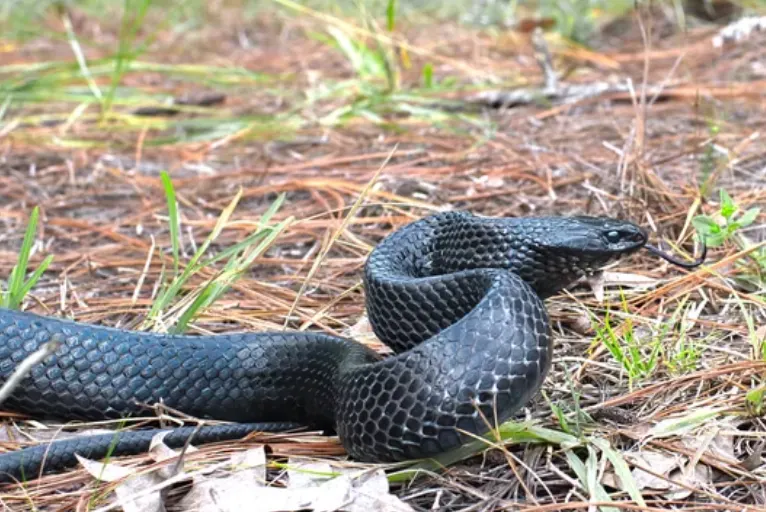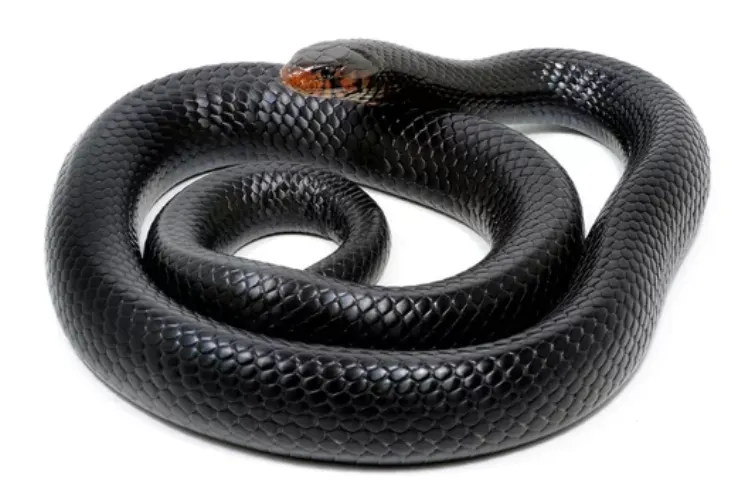The Eastern Indigo Snake (Drymarchon couperi) is one of nature’s most fascinating reptiles. Found in the southeastern United States, this snake stands out for its stunning appearance, impressive size, and its unique ability to hunt venomous snakes. Known as the longest native snake in North America, the Eastern Indigo Snake plays a crucial role in maintaining the health of its ecosystem. In this article, we’ll explore what makes this snake special, where it lives, how it hunts, and what’s being done to protect it.

Table of Contents
A Beauty in Blue: What Does the Eastern Indigo Snake Look Like?
The Eastern Indigo Snake is a true showstopper. Its body is covered in smooth, blue-black scales that shimmer with a purple sheen in sunlight. These glossy scales give it a sleek, almost metallic look. Its chin, sides of the head, and throat have a striking contrast of orange-red coloration, adding to its unique beauty.
In terms of size, the Eastern Indigo is a giant among snakes. Adults can grow up to 8.5 feet in length, with some males even reaching 9 feet! They can weigh up to 11 pounds, making them both long and strong. Despite its impressive size, the snake’s streamlined shape makes it an agile and efficient predator.
Fearless and Fast: The Indigo Snake’s Hunting Style
One of the most amazing things about the Eastern Indigo Snake is its ability to hunt dangerous prey—venomous snakes. While most animals avoid venomous species like rattlesnakes and copperheads, the Indigo Snake actively chases and kills them. Even more fascinating is that the Indigo Snake may be immune to rattlesnake venom, allowing it to survive bites that would be lethal to most creatures.
Rather than using constriction like some other snakes, the Eastern Indigo relies on brute force. When it catches its prey, it uses its powerful jaws to pin the animal against the ground, overpowering it. In addition to venomous snakes, the Indigo’s diet includes small mammals, lizards, birds, turtles, and other reptiles. This varied diet helps keep ecosystems balanced, as the snake plays a key role in controlling both rodent and venomous snake populations.
Where Can You Find Eastern Indigo Snakes?
Eastern Indigo Snakes once roamed a wide area across the southeastern United States. However, due to habitat loss and other factors, their range has become smaller. Today, they are mainly found in Florida, southeastern Georgia, southern Alabama, and parts of Mississippi.
These snakes prefer to live in habitats like pine forests, scrubby flatwoods, and the edges of marshes. They are also known to live in dry prairies and even human-disturbed areas, such as agricultural lands. When temperatures drop in winter, the snakes often seek shelter underground in gopher tortoise burrows, hollow logs, or abandoned rodent holes. These burrows provide a safe, stable environment for the snakes to regulate their body temperature.
The Importance of Conservation Efforts
Although the Eastern Indigo Snake is listed as “Least Concern” by the IUCN, its populations have been declining due to habitat destruction. A major issue is the gassing of gopher tortoise burrows by rattlesnake hunters. This harmful practice not only kills rattlesnakes but also harms Eastern Indigos and many other animals that depend on these burrows.
Thankfully, conservation programs are in place to help. Organizations like the Orianne Center for Indigo Conservation have launched captive breeding and reintroduction programs to restore the Eastern Indigo to its former range. From 2010 to 2019, more than 200 Eastern Indigo Snakes were released into the wild in areas like the Conecuh National Forest in Alabama and the Apalachicola Bluffs and Ravines Preserve in Florida. These efforts are essential to preserving the snake’s future.
Are Eastern Indigo Snakes Dangerous to Humans?
Despite their size and hunting prowess, Eastern Indigo Snakes are not dangerous to humans or pets. These snakes are typically shy and prefer to avoid confrontation. If they feel threatened, they may bite, but they lack venom, and their bite is not harmful to people. They also sometimes release a foul-smelling musk as a defense mechanism to ward off predators.
Eastern Indigo Snake Facts at a Glance:
- Length: Up to 8.5 feet (some males may reach 9 feet).
- Weight: Up to 11 pounds.
- Color: Blue-black with iridescent purple shimmer and orange-red patches on the chin and throat.
- Diet: Venomous snakes, small mammals, birds, lizards, and turtles.
- Range: Southeastern U.S.—mainly Florida, Georgia, southern Alabama, and Mississippi.
- Habitat: Pine forests, scrublands, dry prairies, marsh edges, and human-disturbed areas.
- Conservation Status: Least Concern (IUCN), but efforts are underway to restore populations due to habitat loss.
How Do Eastern Indigo Snakes Benefit the Ecosystem?
Eastern Indigo Snakes are top predators in their ecosystem, which means they play an important role in keeping prey populations balanced. By eating venomous snakes, rodents, and other small animals, they help prevent overpopulation of these species, which in turn helps protect crops and reduces the spread of disease.
Their presence is also an indicator of a healthy environment. A flourishing population of Eastern Indigo Snakes suggests that the ecosystem is in good condition, with plenty of prey and suitable habitats available for wildlife to thrive.

Protecting a Key Species
The Eastern Indigo Snake is a remarkable reptile with an important role in the ecosystems of the southeastern United States. From its dazzling appearance to its fearless hunting of venomous snakes, the Indigo is a snake like no other. While its population faces threats from habitat destruction, conservation programs are making strides to ensure its survival.
By understanding and appreciating the role these snakes play, we can better protect not only the Eastern Indigo but also the delicate balance of nature that depends on their presence. These beautiful, non-venomous giants deserve a place in the wild, where they can continue to chase down rattlesnakes and shine in the sun, their scales shimmering with shades of purple and blue.
- Enchi Ball Python: A Unique and Stunning Morph of Python regius - March 27, 2025
- Emerald Tree Monitor: The Enigmatic Green Guardian of the Rainforest - March 26, 2025
- The Egyptian Cobra (Naja haje): A Fascinating Serpent - March 25, 2025
